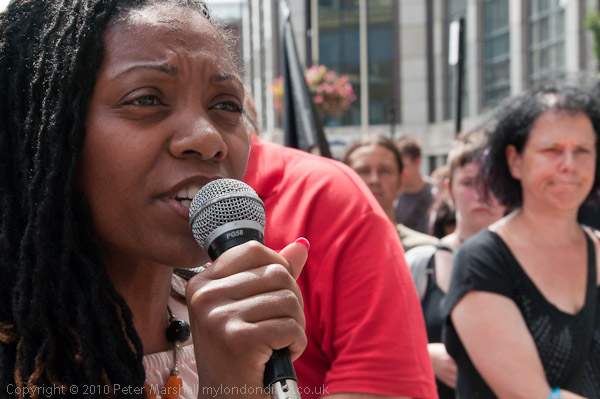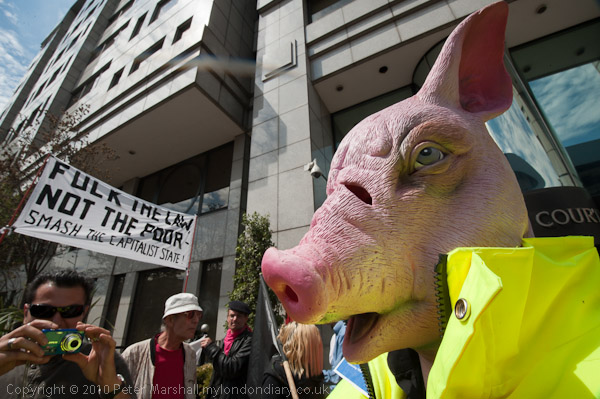The anti-capitalist protest following the decision by the Director of Public Prosecution Keir Starmer not to prosecute the police officer recorded on video assaulting Ian Tomlinson minutes before the death of this previously fit and healthy man, not a demonstrator but simply on his way home from work, was bound to be an angry one. As expected that anger on this occasion, which included several periods of silence in Tomlinson’s memory, was confined to words, both spoken and on some of the banners and placards.

The United Campaign Against Police Violence marching to where Ian Tomlinson died
The decision wasn’t unexpected, which makes it even more shocking. Our political establishment couldn’t let it go to trial because it seemed inconceivable that any jury would fail to convict. Like in the more than a thousand cases of death in police custody since 1969 there would be some kind of cover up, though this was more obvious than most. Not one single police officer has been charged with either manslaughter or murder in even one of these cases. Of course not every single one of these largely unexplained deaths were caused by illegal actions by police, but it is hard to dismiss the evidence that many if not most were.
The police cover up, they lie to support each other. They use pathologists (as in the Tomlinson case) who are known to be incompetent. Above all they hold things up so that lesser charges can no longer be brought and memories fade.
If the boot had been on the other foot (or rather the baton in the other hand) we would have seen the case in court within days and a verdict within a few months. Instead, the case of Ian Tomlinson has taken more than 15 months to come to a decision not to prosecute. Even that is fast – the family of Sean Rigg whose sister spoke at the event are still waiting for the inquest result two years after his unexplained death minutes after being taken in to Brixton police station.

Samantha Rigg-David speaking outside the DPP’s office
So anger isn’t surprising. What is surprising is that so many seem satisfied to put up with the situation without doing anything about it. Perhaps the fact that most of the victims are black and most are working class comes into it.
Photographically one problem was that the anger expressed itself very obviously in the language on some of the banners. Not a problem in some ways, but it can make the publication of images difficult.

In the above picture the banner was not quite fully visible and could read ‘FOLK THE LAW NOT THE POOR’ but in most other images it was less equivocal! At least one other banner included another word not generally used in polite company, and had I been videoing the event the sound track would also have presented problems, particularly during the march.
The above picture also shows another problem I had, related to fingermarks on the lens and shooting as I was with the sun not far out of image, there is a kind of diffuse arc over a part of the building just left of centre towards the top of the image. Unfortunately it wasn’t really visible on the camera back unless I zoomed in, and I didn’t notice it until later.
The other aspect of the banners that worried me slightly was the possibility of defamation, as some quite clearly called a named office a murderer. However given the circumstances it is hard to imagine any possible case being taken over this.
But perhaps rather unusually I should give a warning that the pictures from this event on My London Diary may contain language that some may find objectionable, though in my opinion considerably less objectionable than the decision by Keir Starmer.